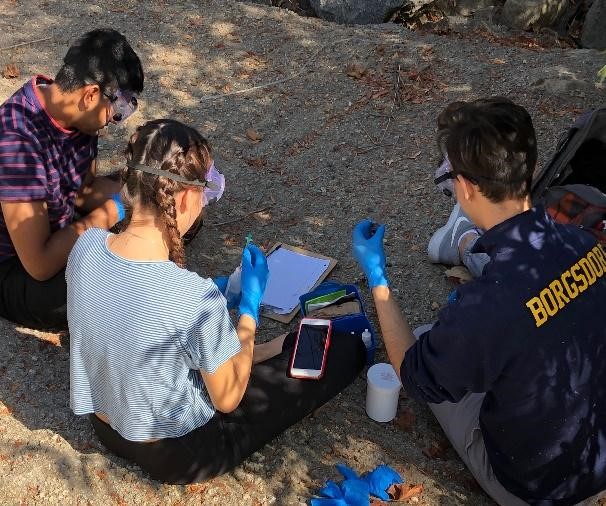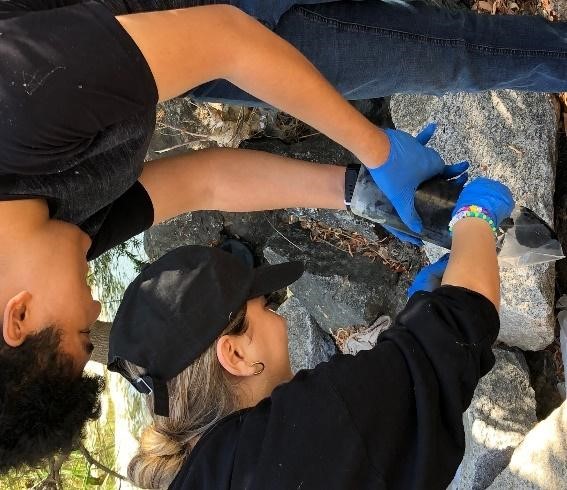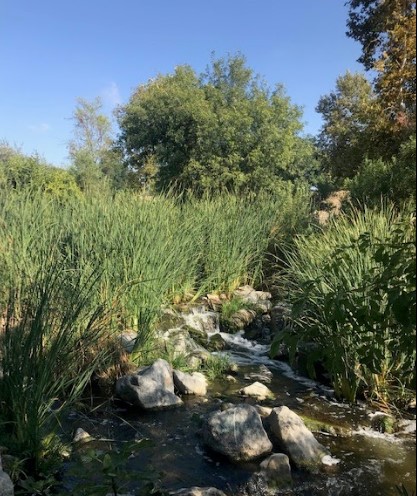Engaging Students in the LA River through Interdisciplinary Science

and Chemistry Students from Granada Hills Charter High School
(GHCHS) Testing Water Quality Parameters at the LA River
By Wendy Hagan, HS Biology and Environmental Science Teacher at Granada Hills Charter High School, Jeanette Chipps, HS Chemistry Teacher at Granada Hills Charter High School, and Virginia Oberholzer Vandergon, Professor of Biology at CSUN
On September 20th, 2019, youth around the world left class and joined fellow students, staff, faculty, and community members to speak out about climate change. This date ideally corresponded with a field trip that a group of students in the Los Angeles (LA) region attended.
These students were outside exploring and collecting data within their local environment. Their class was observing some of the human impacts associated with two different sections of the LA River. They spent the day carrying out investigations they designed to answer investigative questions about their local watershed. These questions entailed connections to environmental impacts in relation to water quality parameters and/or possible containments suspended within the LA river water and/or sediments. They collected plastics (both micro- and macro-) and tested such water quality parameters as pH, dissolved oxygen, nitrates, phosphates, mercury, lead, and water hardness. This field trip has evolved as a collaboration between an environmental science teacher and a chemistry teacher with support from several local organizations, such as CSUN (California State University, Northridge), FOLAR (Friends of the LA River), and the CEEF (California Environmental Education Foundation). These two teachers have spent the last three years developing a collaborative Next Generation Science Standards (NGSS) 5E unit on water chemistry in our local area that culminates with a field trip to the LA River.

Dissolved Oxygen Data at the LA River
The 5E lesson sequence begins with an engage which has students designing a water filtration system. This has varied from a “Design Your Own Water Filter” challenge to a nanoscience filtration lab. In this engage section, students learn to think about what impacts dirty water might have on populations (including humans) and what methods might already exist to clean water. Students then explore water quality parameters and methods to test water quality. In chemistry, students explain redox reactions and titrations or the stoichiometry of water quality. In environmental science, students explain the ecological impacts of various human activities and the possible effects on water quality. In addition, students start to make connections between local and global ecological impacts and water quality.
In another explore/explain cycle, students go on a field trip to the Aquarium of the Pacific to measure dissolved oxygen in the Long Beach Harbor and discuss where water from the LA river ends up. They also explore the watersheds exhibit and learn about the source and overall flow of the LA River watershed and the different influences along the river's course through the LA region. Students then investigate maps and images of the LA River and compare the difference in vegetative cover, concretization, the flow of runoff, historical sites (like the Superfund sites), types of communities, urbanization, etc. surrounding the LA River.

from the LA River to Test for Microplastics
Finally, students elaborate on our initial explorations, investigations, and experiences and design an experiment to test how these different ecological and/or human communities could impact the quality of water and/or sediments in our local watershed. Students design their own sampling methods to test their investigative questions. They collect data in the field, analyze and interpret the data using statistical analyses, and then construct scientifically-based explanations. Finally, they evaluate their work through thoughtfully written self- and peer-reflection. Typically, students then took action and designed a service-learning project advocating for local change that could also make a global impact.

Metals, such as Iron, Lead, and Mercury in the LA River
The first few years of this lesson sequence, students went to Limekiln Canyon Park in Porter Ranch. It was beneficial for students to realize that the start of LA River which spans 48 miles through the LA region is in their own backyard. On a day-to-day basis, we interact with nature in ways we don’t even realize. Many of our students hike the trail or run around similar canyons without stopping to consider the impact they are having on those environments. When taking students in the field or on hikes, we have these unique opportunities to ask questions and elicit observations of the natural world. We, as teachers, have this opportunity to facilitate learning and have them search for ways we impact our environment, both positively and negatively. Due to drought and low water resources in the fall, our field site location needed to be re-evaluated. Inspired by the CSUN Science Learning Collaboratory (CSLC), the field location spanned to a larger scale. Our students now got to explore a more comprehensive portion on a larger scale of their local watershed. Prior to participating in the field trip, students were asked to describe the LA River. Several snickers of “what river” and lots of discussion of concrete were the first comments to be made. The students were showed pictures of a river and asked them to guess if it was in California or another state, students were shocked to learn that images such as Figure 5 came from LA. These comments made us realize the importance of engaging students with the LA River.

NGSS encourages teachers to use local phenomena with our students and what could be more local for them then the river in their own backyard. There were many opportunities for AH HA’s within this lesson unit, but one significant moment came when our students researched the impact of humans on this environment and they became aware of the influence of trash on the river. Students now understand what the signs on storm drains mean.
This NGSS 5E unit can be modified for several levels of science courses. This 5E lesson sequence was implemented in our international baccalaureate classes, but we are also using it in general chemistry courses. In IB Chemistry, this lesson sequence and local phenomenon fits well with redox titrations and the Winkler method for dissolved oxygen. Students discussed stoichiometry and chemical reactions within general chemistry as well. In addition, this local phenomenon and similar 5E lesson design can be applied to impacts to biodiversity, disturbances within systems, and overall, the flow of energy and matter within a system for biology and environmental science. The connections are limitless and can span through all disciplines of science.






